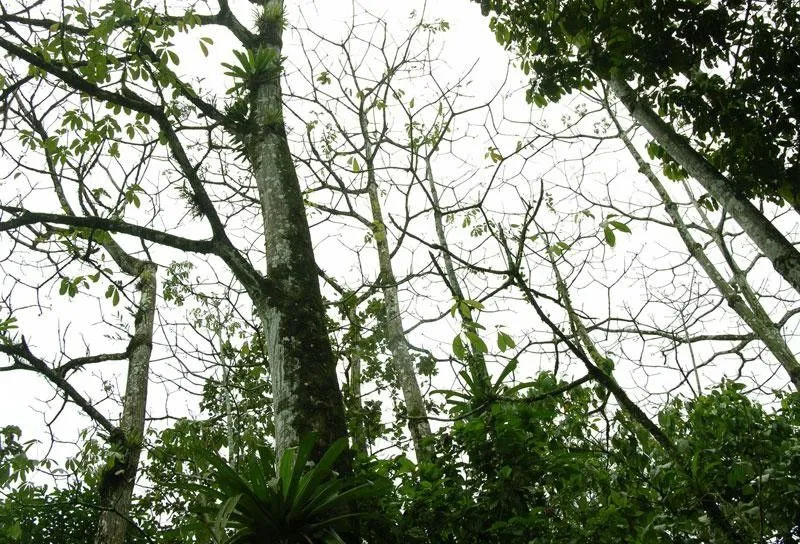
Author: (Jacq.) Dugand
Bibliography: Caldasia 2: 65 (1943)
Year: 1943
Status: accepted
Rank: species
Genus: Pseudobombax
Vegetable: False
Observations: C. & S. Trop. America
The Barrigon kapoktree, scientifically known as Pseudobombax septenatum, is a notable species within the Malvaceae family. This striking tree, often found flourishing in Central and South America’s tropical regions, captivates admirers with its unique structure and ecological significance.
The Barrigon kapoktree stands tall and majestic, characterized by its bulbous trunk that tapers off into a more slender form as it ascends. This distinctive swollen trunk, which resembles a belly (hence the name “Barrigon”), serves as a water storage system, allowing the tree to survive through dry seasons and ensuring its resilience in various climates. The vibrant green bark of the younger branches and its striking, smooth texture add to the tree’s aesthetic appeal.
In its natural habitat, the Barrigon kapoktree plays a crucial role in the tropical ecosystem. It thrives in a range of environments, often found in both humid and dry tropical forests. The tree’s flowers are another point of interest; they are large, white, and fragrant, attracting numerous pollinators, including bats and insects. These nocturnal visitors are crucial for the tree’s pollination process, ensuring the propagation of the species.
Leaves of the Pseudobombax septenatum are another distinguishing characteristic. They are palmate and compound with leaflets arranged symmetrically, providing a lush, green canopy that contributes significantly to the forest’s overall aesthetic and ecosystem. This dense foliage not only offers shade to the understory plants but also serves as a habitat for various epiphytic plants and animal species, fostering biodiversity.
Further enriching the ecosystem, the seeds of the Barrigon kapoktree disperse primarily via wind, thanks to their lightweight and cottony fibers. These fibers also have potential uses in various local industries, although they are not as commercially exploited as those from its relative, the true kapok tree (Ceiba pentandra).
The academic and scientific community recognizes its significance through detailed studies and bibliographical records, one of which was published by Caldasia in 1943. The tree’s botanical classification was authored by Dugand, further highlighting its importance and the depth of study surrounding it.
In local folklore and culture, the Barrigon kapoktree often holds a symbolic presence. Its prominence in the landscape makes it a landmark and, occasionally, a subject of myths and stories among the indigenous populations.
Overall, the Barrigon kapoktree (Pseudobombax septenatum) is not only an awe-inspiring natural marvel due to its physical attributes but also an integral part of the tropical forest ecosystems of Central and South America. Its roles in habitat creation, ecological balance, and cultural significance underscore the importance of conserving this remarkable tree.
Spa: ceiba barrigona, barrigón, ceibo barrigón
En: Barrigon Kapoktree
Es: Barrigón, Ceibo barrigón, Barrigón., Ceiba barrigona
: Barrigon kapoktree
Taken Apr 5, 2017 by Hervé Goëau (cc-by-sa)
Taken Apr 7, 2021 by Salado Carrera Gustavo Enrique (cc-by-sa)
Taken May 11, 2015 by Salado Carrera Gustavo Enrique (cc-by-sa)
Taken Apr 17, 2019 by OTS – O. Vargas (cc-by-nc-sa)
Taken Jul 19, 2020 by Uriel Argel (cc-by-sa)
Taken Apr 5, 2017 by Hervé Goëau (cc-by-sa)
Taken Jun 19, 2022 by Uriel Argel (cc-by-sa)
Taken Apr 17, 2019 by OTS – O. Vargas (cc-by-nc-sa)
Taken Apr 17, 2019 by OTS – O. Vargas (cc-by-nc-sa)
Taken Apr 17, 2019 by OTS – O. Vargas (cc-by-nc-sa)
© copyright of the Board of Trustees of the Royal Botanic Gardens, Kew.
© copyright of the Board of Trustees of the Royal Botanic Gardens, Kew.
© copyright of the Board of Trustees of the Royal Botanic Gardens, Kew.
Taken Apr 16, 2016 by Nelson Zamora Villalobos (cc-by-nc)
Taken Apr 16, 2016 by Nelson Zamora Villalobos (cc-by-nc)
Taken Aug 18, 2016 by Nelson Zamora Villalobos (cc-by-nc)
Taken Apr 17, 2019 by OTS – O. Vargas (cc-by-nc-sa)
Taken Apr 17, 2019 by OTS – O. Vargas (cc-by-nc-sa)
Taken Apr 17, 2019 by OTS – O. Vargas (cc-by-nc-sa)
Taken Apr 17, 2019 by OTS – O. Vargas (cc-by-nc-sa)
Taken Apr 17, 2019 by OTS – O. Vargas (cc-by-nc-sa)
Taken Apr 17, 2019 by OTS – J. González (cc-by-nc-sa)
Taken Apr 17, 2019 by OTS – J. González (cc-by-nc-sa)
Taken Apr 16, 2016 by Nelson Zamora Villalobos (cc-by-nc)
Taken Apr 17, 2019 by OTS – J. González (cc-by-nc-sa)
Taken Apr 17, 2019 by OTS – O. Vargas (cc-by-nc-sa)
Family: Myrtaceae Author: (F.Muell.) K.D.Hill & L.A.S.Johnson Bibliography: Telopea 6: 402 (1995) Year: 1995 Status:…
Family: Rubiaceae Author: Pierre ex A.Froehner Bibliography: Notizbl. Bot. Gart. Berlin-Dahlem 1: 237 (1897) Year:…
Family: Sapindaceae Author: Koidz. Bibliography: J. Coll. Sci. Imp. Univ. Tokyo 32(1): 38 (1911) Year:…
Family: Asteraceae Author: A.Gray Bibliography: Pacif. Railr. Rep.: 107 (1857) Year: 1857 Status: accepted Rank:…
Family: Fabaceae Author: Medik. Bibliography: Vorles. Churpfälz. Phys.-Ökon. Ges. 2: 398 (1787) Year: 1787 Status:…
Family: Aspleniaceae Author: (Cav.) Alston Bibliography: Bull. Misc. Inform. Kew 1932: 309 (1932) Year: 1932…